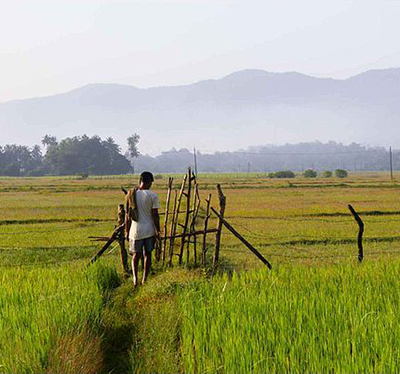UCAR, India join forces on weather technology and prediction
Memorandum of understanding with India Ministry of Earth Sciences will advance forecasting and observations
Oct 7, 2014 - by Staff
Oct 7, 2014 - by Staff
BOULDER — U.S. atmospheric researchers and their counterparts in India will join forces to advance weather forecasting and technology under a new agreement between the University Corporation for Atmospheric Research (UCAR) and the India Ministry of Earth Sciences.
The memorandum of understanding (MOU) will support collaborations to improve forecasts of major weather events in India, including monsoonal rains that are critical for growing crops that feed hundreds of millions of people. In turn, the knowledge gained from insights into India's weather patterns will help U.S. researchers advance their own forecast skills to better predict events closer to home.

A farmer in an Indian village. India’s vast population and extensive agriculture make prediction of the annual monsoon a critically important tool. (Wikimedia Commons photo by Ramnath Bhat.)
"If we can help advance their forecast skill while learning more about long-range prediction, it will save lives in India as well as improve our own forecasts for similar events at home,” said UCAR president Thomas Bogdan. “There are some important synergies that can benefit both countries."
Collaborations are expected to involve research on aircraft and radar technology, nowcasting of severe weather events, hydrometeorology, satellite data, oceanic and climate research, and urban flooding. A particularly important area is long-range prediction, potentially helping Indian farmers with planting decisions based on the projected intensity and timing of the next monsoon season.
One of the first collaborations is expected to focus on a new technology that produces highly detailed measurements of wind in the lower atmosphere. Scientists at the National Center for Atmospheric Research (NCAR), which is managed by UCAR on behalf of the National Science Foundation, have developed a 449-MHz Modular Radar Wind Profiler. With its adaptable design and novel, inexpensive power amplifier, the wind profiler may be set up as a network of radars for the lower atmosphere or as a single large wind profiler able to take measurements as high as the stratosphere. Such observations can improve forecasts of monsoons, thunderstorms, frontal systems, and other weather events.
"Accurate weather forecasts and long-range outlooks have extremely high value to the Indian economy and the needs of the nation's farmers," Bogdan said.
The MOU covers scientists at NCAR, UCAR, and UCAR's 100-plus member universities. In India, it covers a range of institutions and scientists funded by the India Ministry of Earth Sciences.